what causes high power lines to sound like static
Also run across Radiated and Conducted Dissonance
Distribution lines are the loftier voltage lines that distribute power along residential and light commercial feeds. Many years ago these lines were simply over 2200 volts, then 4160 volts (from main to neutral) became a standard. Many amateurs used surplus 4160 transformers in power supplies! I once had a 572B amplifier using a 4160 pole pig. The line voltage switch (2.5% taps) was at the eye of the winding, making a great center tapped winding. Back around 1970, I ran about 2900 volts on the plates of four Cetron 572B's.
In the 1970's, I started building racket locating equipment and repairing noise locating equipment for utilities. 1980's and later, I subcontracted work for a few small (and one major) companies locating more difficult cases of power line dissonance. As I quit working with utilities, most residential arrangement were 7200 volts from primary to neutral. My local feed today, on a rural clay road with single phase, is 7200 volts.
Ability Line NoiseIdentify Your Noise!
Distribution power line noise is generally a raspy buzz. Electric line generated noise on normal distribution lines is modulated at some depression harmonic of the ability line frequency. Almost ever the single phase "buzz" is 120 Hz. This is because racket is from small arcs (usually in insulators or pins), and the arc nearly e'er occurs twice in each cycle most the negative and positive voltage peaks of the 60 Hz sinewave. Power line noise is broadband. Power line noise does non announced in clusters or periodically beyond any given ring, although level tin can modify profoundly from ring to band. Switching noise and digital noise from consumer devices is almost e'er periodic. The periodic appearance across a given band occurs because nearly consumer dissonance is generated by a high frequency clock or oscillator'southward harmonics. If the fourth dimension base or oscillator of the consumer device is 30 kHz, noise generally appears every xxx kHz across a ring. At that place volition more often than not (only not always) be clear spots between dissonance peaks. Some forms of modern digital noise can sound like power line noise. One example is my neighbor's Straight TV recorder arrangement. The Direct Television set device they take far exceeds FCC emission limits. From mid-AM broadcast ring to mid HF, it sounds simply similar a residential distribution power line noise and the raspy buzz it generates follows the ability lines. It disappears in a higher place x MHz.
Manual line systems, the really big lines running from town-to-town, run at much higher voltage. Because of that, the noise is generally different. The dissonance ranges from a sharper fizz to a hissing with a faint 120 Hz or college note. Loftier voltage manual line noise can sneak upwardly on us, making us recall we accept normal background noise because at times it blends into normal background hiss. This is because the arc or belch, being from a much higher voltage, ofttimes lasts over a much larger portion of the cycle. It also tin can involve multiple phases. This smoothes or softens the noise, just if yous mind carefully there is generally a trivial 120 Hz, 240 Hz, or 360 Hz slightly musical buzzing present.
Power line noise is relatively frequency independent, usually having only a very gradual alter in level with frequency. Ability line racket can be band specific, just it is never frequency specific. Light dimmers and other consumer devices can be the same.
If a noise is frequency periodic, peculiarly a signal repeating with 10 kHz or more spacing betwixt peaks, it is probably a switching power supply or digital device of some type.
CB jargon sometimes mistakenly refers to line noise every bit land-dissonance or footing-noise, very unusual slang since neither the basis nor the land is a source of noise.
Distribution organization power line noises originate in the post-obit items, each of which has subtle but unique characteristics in pitch or sound. Some sources also start and stop in response to weather condition:
- Pin or hardware arcs on insulators, generally bong insulators. Often quiet in wet weather, and almost always wire-motility sensitive
- Arcs from loose clamps or bolts that join wires. Frequently sensitive to hard hits on the pole, but can driblet dangerous molten pieces of metal
- Arcs in hardware, similar lightning arrestors. Not usually affected past weather
- Arcs in hardware near, but not connected directly to, power lines. These are by and large much worse when dry out, but usually unaffected past pole movement
- Poorly wrapped or insulated tie wires that secure power lines to knob insulators. This is another dry out weather arc, normally on VHF and college
- Arcs inside equipment, like internal arcs in transformers. These arcs are generally unaffected by conditions or wire movement
Insulator Pivot or Hardware Arcs
These arcs are primarily, but non always, dry-weather noises.
This type of dissonance is generally a higher-pitch raspy or rough noise. Pin noise or hardware arcs between loose pieces of metal on the pole nearly always go abroad in wet weather. This is because moisture wets the dielectric (oxide or corrosion) in the pin area making it conductive, and that stops the arc. This particular racket source also "breaks upwards" when poles and wires wiggle or move. When I did racket investigation for a few utility companies, I would strike the suspected pole with a large hammer and listen for the noise to "break up". Another method I used (afterwards looking to see the guy wires were well clear of whatever hot lines) was to milkshake or push button on guy wires. You should non do this without permission of the pole owner. I had permission.
Insulator pin arcs are one of the most common sources of broadband noise on power lines. This noise is caused by low tension on bell insulators, assuasive them to hang with visible sag or slack. The noise is generally a medium to low level racket with a higher sounding smoother pitch because the arc is weak with very low current, but like all noises it can propagate a long altitude forth the lines.

The pins on each end of insulators tin be a common source of dissonance. The long insulator higher up is a newer Polymer type. Information technology does not accept the leakage capacitance of older ceramic bell insulators, and is not as noisy when span tension is low. The pins withal are the same in virtually all insulators. With low tension the pins corrode and brand poor contact. This can cause a very tiny arc. The arc excites the power line through the insulator'due south stray capacitance and the power line acts like a behemothic antenna. A few milliwatts of free energy can radiate a long distance when using a long wire antenna like a power line!
Sources of Noise on typical pole
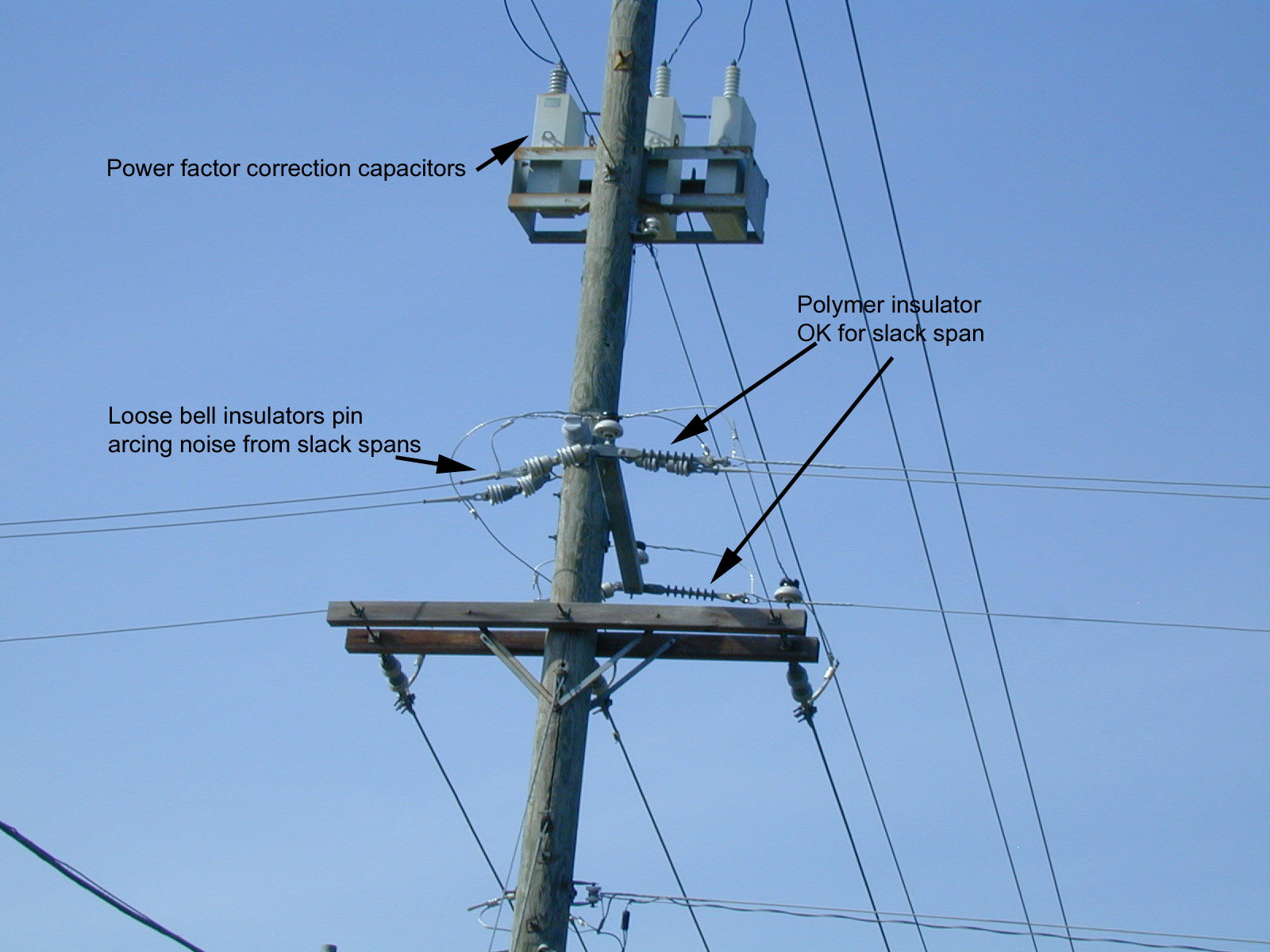
Loose connections on power factor correction capacitors can arc for many years without dissentious annihilation. This is generally an all weather noise.
The bracket of the capacitors should exist grounded to the pole ground wire, and the capacitor, solidly. Non bonding mostly makes a dry weather noise, and is a prophylactic hazard to workers
Polymer insulators tin have slack spans or depression tension with piddling likelihood of noise. Since they are very long and have very low cease-to-end capacitance, they are unlikely to have plenty voltage at the pole terminate to arc, fifty-fifty when loose. They are practiced problem-gratuitous insulators.
Loose ceramic bell insulators are bad news, particularly in dry weather! The large metal caps towards the pole side capacitive couple to the hot wire side. This bell-style insulator has considerable capacitance from the hot end of the insulator to the basis cease. Information technology should never exist used in slack spans. Slack spans should use mail service mounted insulators or long polymers to minimize capacitance and increase leakage path betwixt the ends.
Most often a dissonance problem with slack spans is rooted more in the capacitance of the insulator than actual leakage across the insulator surface, although both tin can be involved.
The longer polymer insulators on the pole above have a long fiberglass rod core and a very long external leakage path around the ribs. Ceramic bell insulators have a very big metal casting capping the depression voltage or grounded cease, and take an interlocked center pin and body cap separated by ceramic. Spacing is pocket-size and parallel surface areas are big in the more than compact ceramic insulators, causing very loftier capacitance betwixt the metal cap and the centre pivot of the ceramic insulator. The longer multi-ribbed polymer insulators have very low capacitance and a long leakage path, and so they practice not couple from end-to-cease near as well as the ceramic bell insulators. A bridge might accept to exist left slack if the pole can non be back-guyed. Polymer insulators are preferred when a span has to be left slack.
Pins that secure the insulator to the hardware volition corrode and build up a sparse layer of insulation. When a bridge is slack (under low tension) the insulator metallic cease cap, the floating pin that locks the end cap to the eye commodities or mounting hardware, and the mounting hardware will arc across the affair layer of corrosion in the joints. This is considering the pivot is not pulled tightly against the mounting hardware and a small arc develops across the corrosion in the joint. In moisture atmospheric condition the arcing will oft stop and the line become quiet. Slack spans with bell insulators are mostly a dry out weather problem.
Loose Clamps and Hardware on Poles
Loose hardware on poles and wires is a common problem. Information technology is also a safety upshot! This type of trouble mostly makes a severe raspy potent noise over all bands. This blazon of dissonance is generally unaffected by moisture, although it can get get either louder or quieter in rain. If information technology is arcing from something being ungrounded, dissonance will generally go away in the rain. If it is a loose connection on a through connection, similar a loose nut on the transformer primary connectedness, it will come up and go, being largely independent of wet.
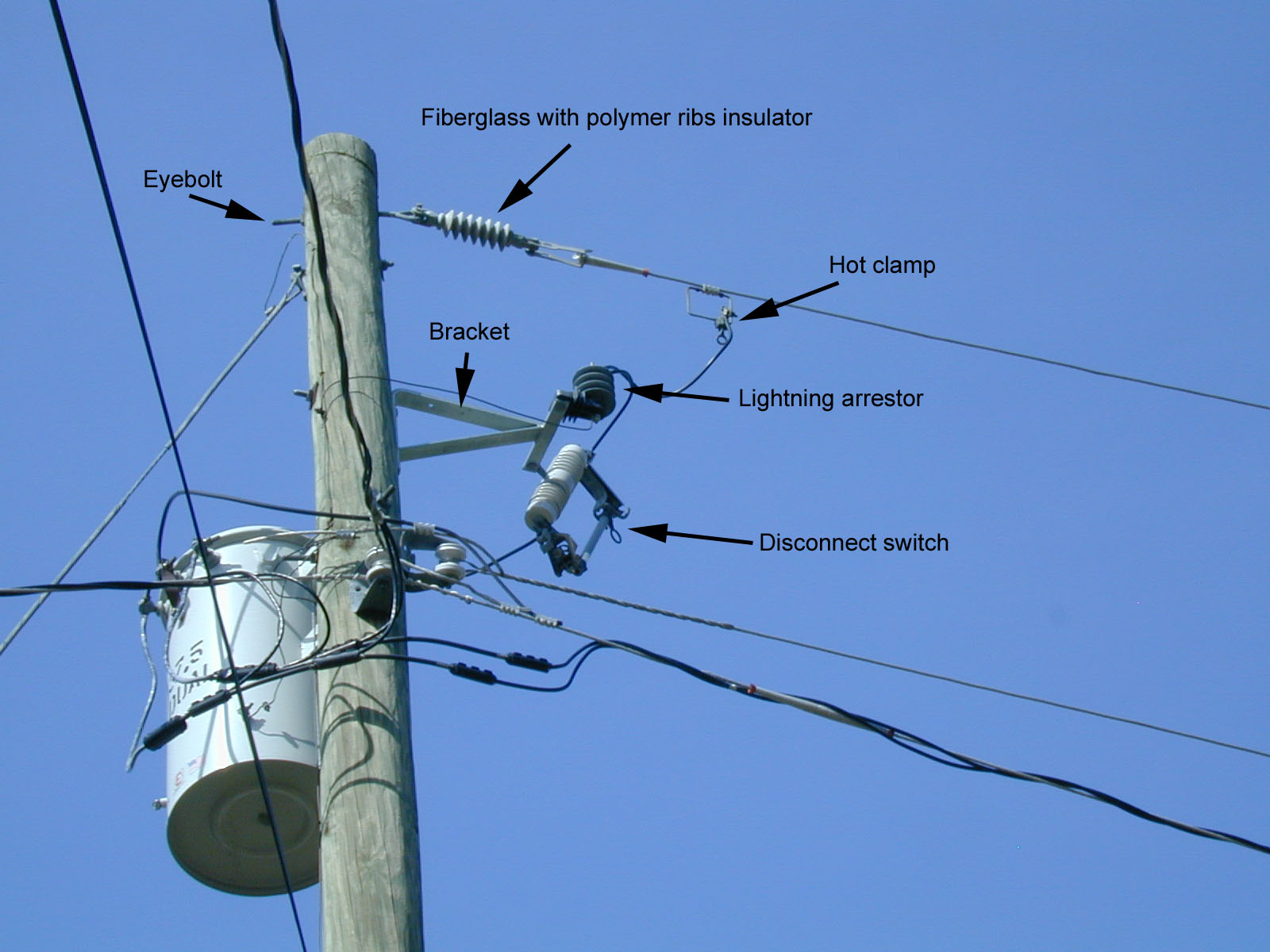
All metallic hardware should exist solidly bonded to the ground wire on the pole or it should exist well-insulated from annihilation else. This is important for minimizing radio dissonance as well as protecting utility workers. Information technology also reduces the chances of lightning harm.
Note the eyebolt at pole top is grounded through a wire to the guy wire and the vertical footing wire running up the pole.
All hardware should ground to the pole basis. The bracket to the left, for example, should be deeply grounded to the ground wire running down the pole.
Discover this utility let the bracket float. (the line that might be a ground wire to the bracket is actually a shadow)
While a well-insulated ungrounded subclass won't make noise, it does create a rubber run a risk to linemen.
If the disconnect switch insulator should ever arc through, develop leakage, or crack the bracket would become hot. If the lightning arrestor would fail shorted and blow its footing wire off, and so the bracket could have total main voltage. If the basis wire was close just not touching the footing wire, information technology could arc from normal leakage and crusade radio dissonance. The bracket either needs to exist a long distance away from the footing wire, or it needs to be bonded to the ground wire. The all-time installation would bond the bracket into the pole ground wire.
The eyebolt holding the polymer insulator should also either be solidly grounded, or it should exist kept abroad from the ground wire. Over again the safest installation for linemen would be with a grounded subclass.
Hot clamps and other line hardware should be tight. Some of the most astringent dissonance sources are loose hot clamps and corroded disconnect switches. Loose connections can really start fires in dry weather.
Ballasts in street lamps tin likewise be a problem.
Other Not-utility Sources
Off-on buzzing noises, timed with a regular rhythm, are oftentimes small permanently wired electrical transformers, heating pads, fish tank heaters, and older electrical fences.
Electrical fences are generally about ane second on and one 2nd off. Noises are caused past bad splices and connections, or wires contacting something that causes a small arc.
Small-scale transformers ofttimes take a thermal cutoff switch. They unremarkably pulse slower than an electrical fence. The general cause is a shorted secondary excursion, which in turn overheats the transformer and causes the thermal bimetal overload switch to bike off and on as the transformer winding heats and cools internally. Small heating pads are like in time.
Heating elements for fish tanks and big electric blankets are often very slow in cycling with long off times.
Frequency-periodic drifting signals are usually switching power supplies of some blazon.
Actually broadband almost indescribable trash that is almost white noise often comes from plasma TV sets.
Locating Noise
For you lot own noise locating equipment, it is all-time to utilize AM detection. Information technology is important that any impulse or arc detector employ a wide IF bandwidth and AM detection. AM broadcast receivers work after a fashion, but make localizing noise to one particular pole difficult or impossible. This is considering the wavelength of the AM band is very long. Wires and conductors forth the electric system conduct longer wavelength racket with very little attenuation. Another effect is standing waves, which can make the same noise pinnacle and null equally the receiver moves along the wires. The combination of low attenuation with distance and standing waves forth the wires tin brand it very difficult to pivot down the exact source. As such, AM receivers have very limited utility for narrowing down source locations.
The very best receivers are VHF or UHF AM receivers, like erstwhile television field strength meters. Another commonly available and relatively cheap receiver is a regular portable aircraft receiver. A few FM portables or mobiles for amateur apply include aircraft band, or selectable AM detection.
Commercial Gear
This is a very broad tuning range bombardment-powered receiver with a wide IF bandwidth. It has an AM detector and attenuator. This Sprague noise interference locator was typical of handheld noise locating devices used by utility companies. It is one of many RFI locators I used when doing consulting. It tunes from the low AM circulate range up to UHF in 1 tuning range!
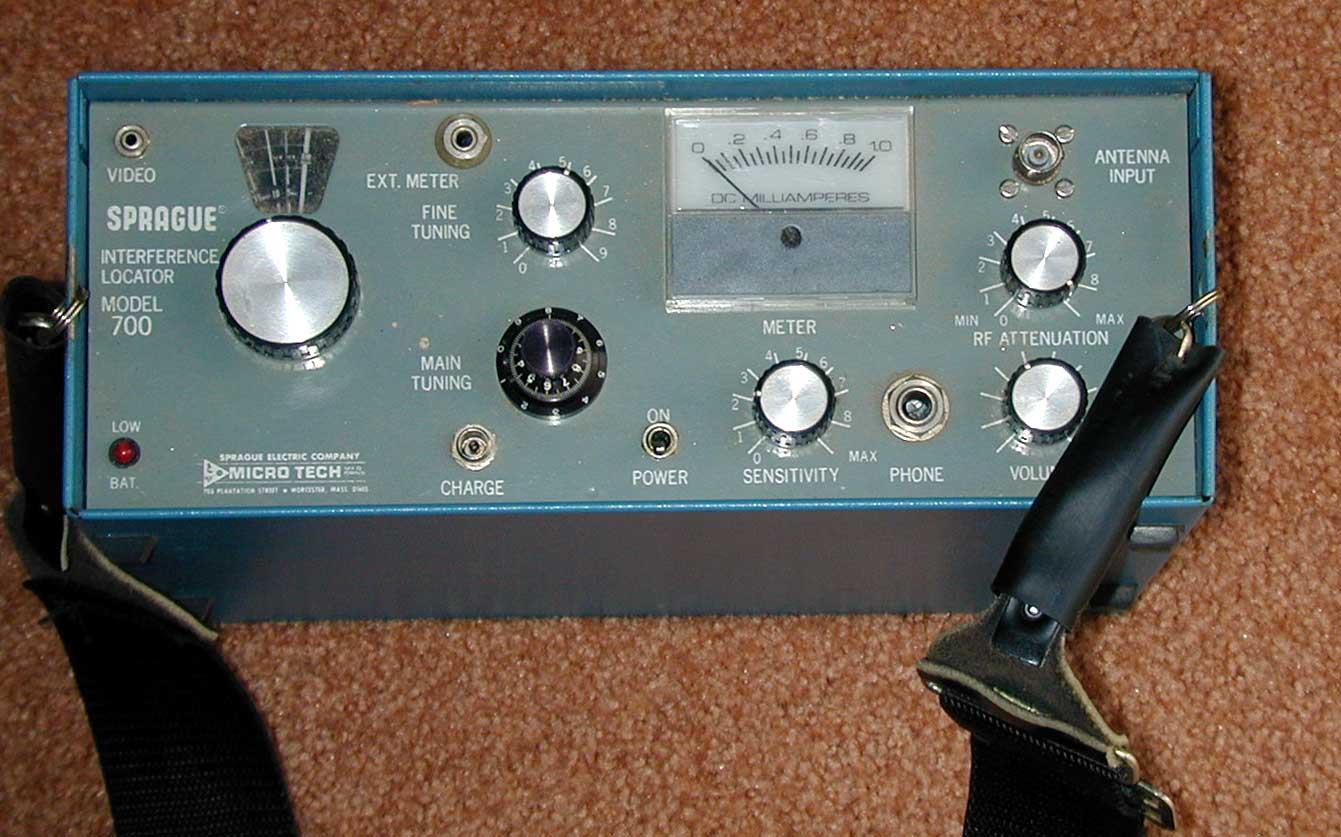
The basic receiver is very much like bootleg units I congenital for utility companies.
My units used ii detectors. The start detector used a variable capacitor tuned local oscillator and mixer. It up converted to a 40 MHz IF organisation driving a video detector. The IF system was actually an IF and video detector module from a standard TV set. I switched betwixt the depression frequency mixer (xl MHz downwardly) to television set varactor VHF and UHF tuners.
This commercial unit is very similar. It up converts to a UHF TV tuner and IF system. A unmarried punch tunes from below the AM broadcast band to UHF.
This unit has an internal battery, and uses several different hand-held antennas shown below in order of descending frequency.

upper VHF and UHF directional antenna
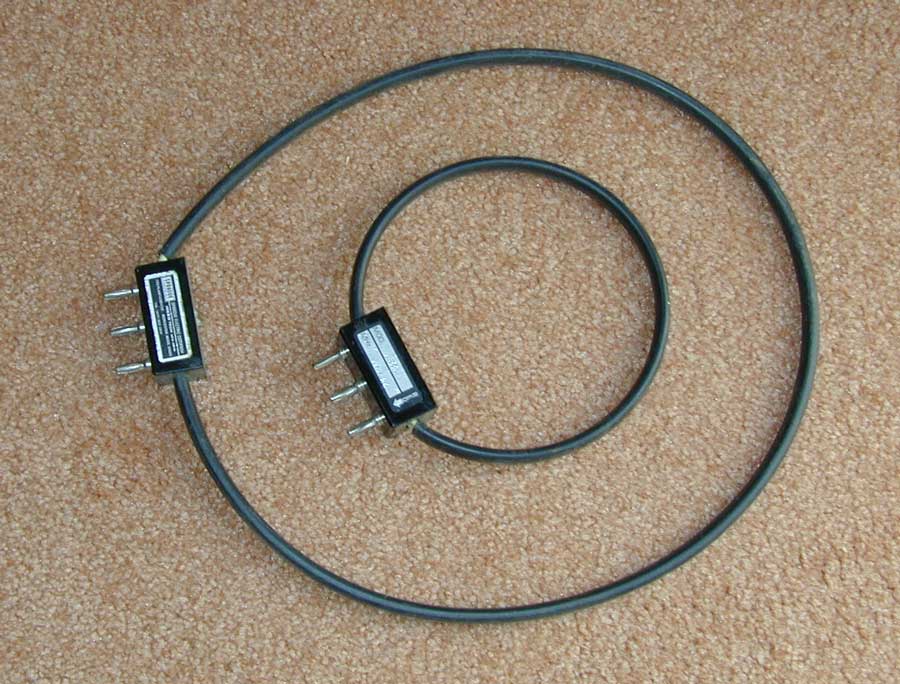
Low VHF to upper HF loop, within a bigger mid to upper HF loop.
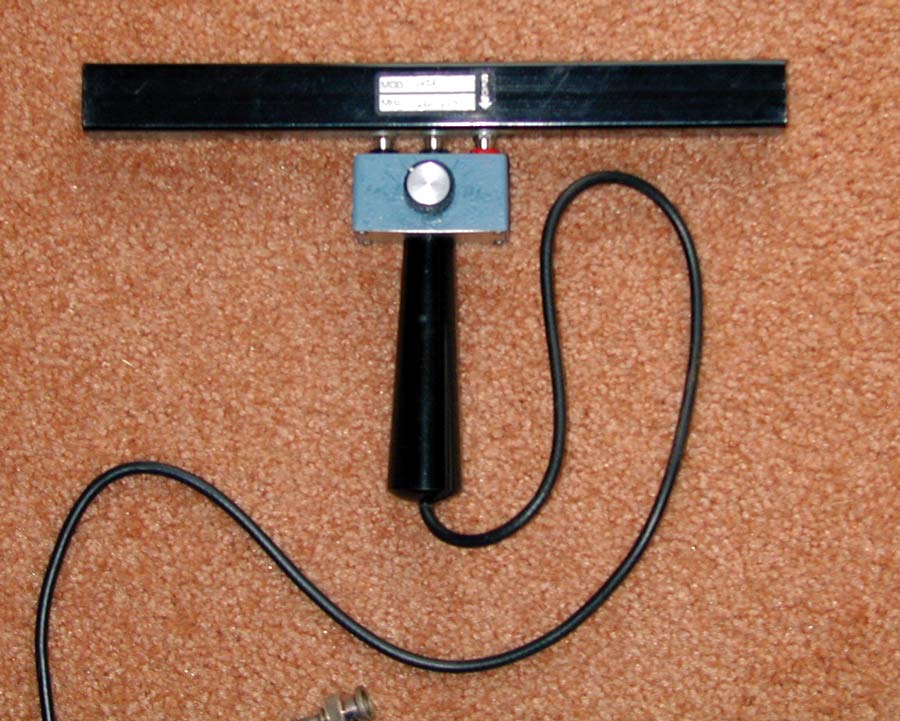
Broadcast to mid-HF rod antenna.
This rod antenna is plugged into the hand unit that contains the tuning capacitor.
The rod antenna is bidirectional.
This is a home brew loop I made. It includes a built in amplifier and band switches from AM circulate up through 10 MHz.. I also utilize it in conjunction with a MFJ-259B meter to locate cached cables. I can discover the location of surreptitious cables within one inch using this loop!
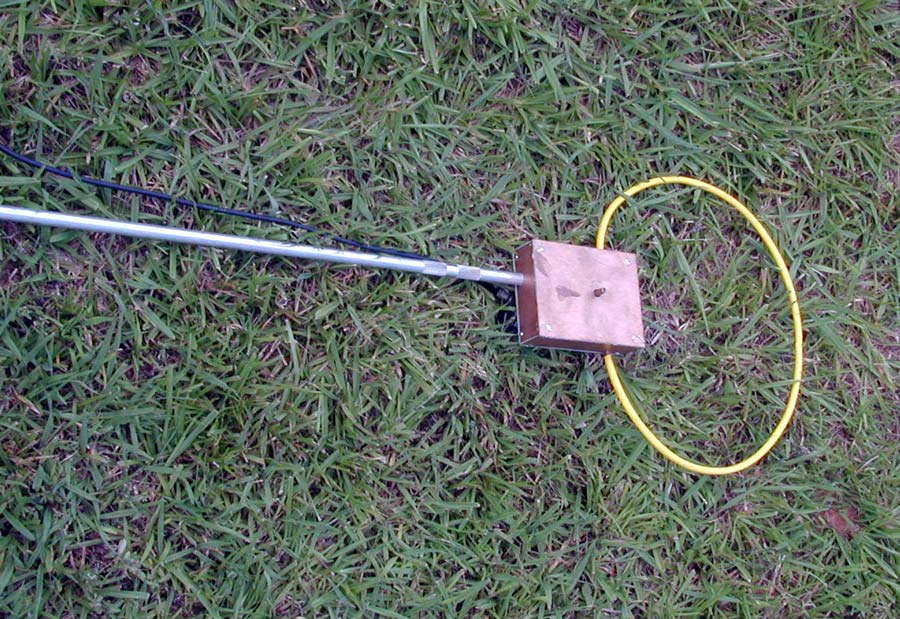
The yellowish area is yellow heat shrink over v/16th inch copper tubing. The gap or split in the tubing is at the very top, reverse the copper tuning box.
The lesser ends of the copper tubing run through and solder to the copper box. Multiple turns within are tapped past a switch, and tuned by a 200 PF variable capacitor
This loop, because it employs a JFET amplifier, is very sensitive.
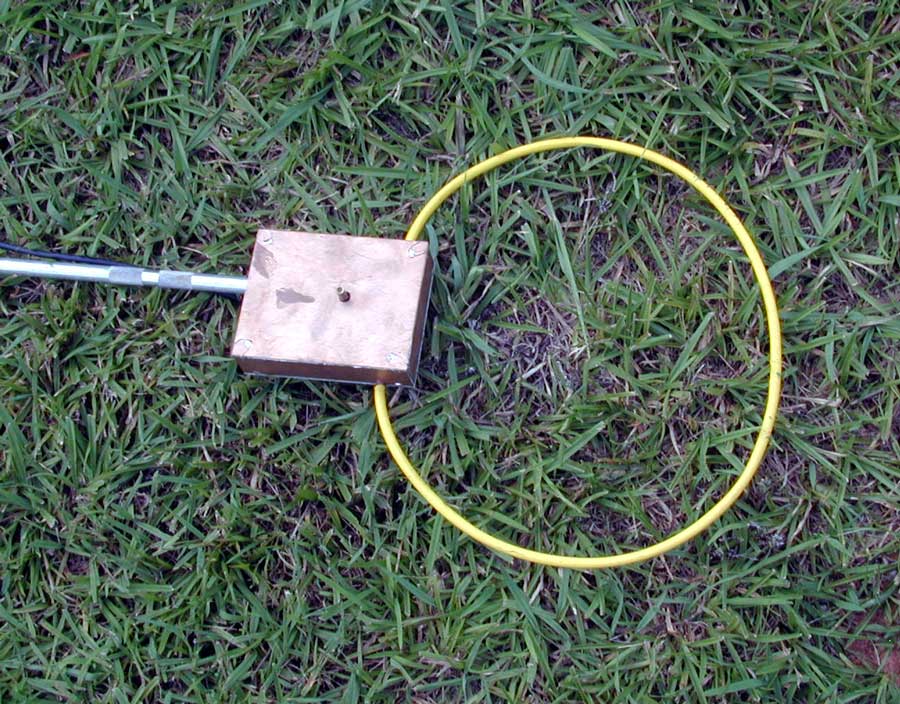
The null is though the loop center.
This loop makes an excellent cable locator.
I easily discover the location of underground cables with this loop and a modest bespeak source, similar the MFJ-259B.
Source: https://www.w8ji.com/power_line_noise.htm
0 Response to "what causes high power lines to sound like static"
Enregistrer un commentaire